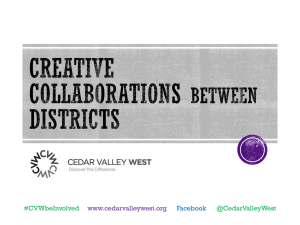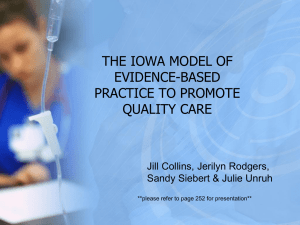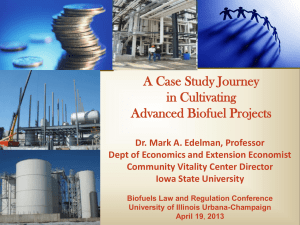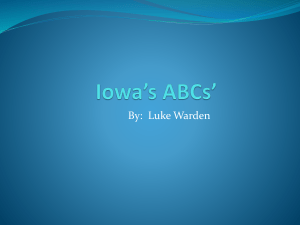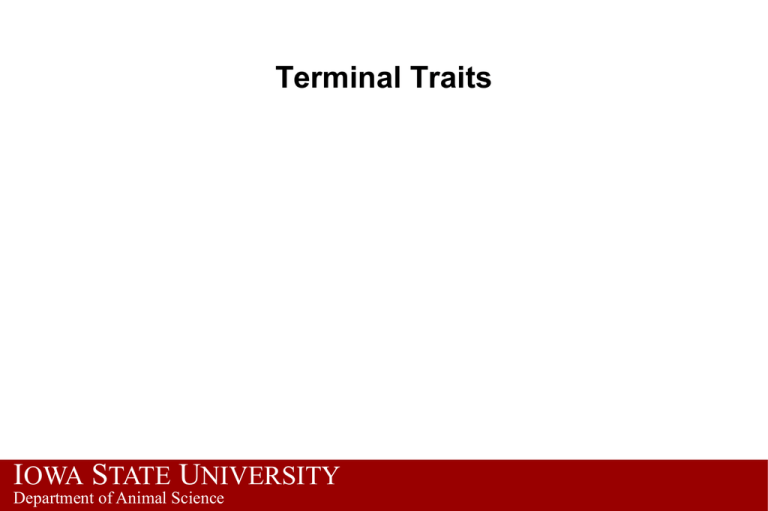
Terminal Traits
IOWA STATE UNIVERSITY
Department of Animal Science
Heterosis Review
What is Heterosis - offspring performance difference over
the average performance of an offspring’s parents
Why maximize heterosis?
It is FREE producers are wasting money if you do not take advantage of it.
Performance of Sire = 2.00 ADG
of Dam= 1.80 ADG
Parental Average = 1.90
Offspring Average ADG = 2.10
Offspring – Parental Average = 2.10 – 1.90 = .20
Percent Heterosis = .20 /1.90 = 10.5%
IOWA STATE UNIVERSITY
Department of Animal Science
Types of Heterosis
1. Individual
Advantage of a crossbred offspring over purebred parents
2. Maternal
Advantage of a crossbred mother over a purebred mother
Primarily due to mothering ability
3. Paternal
Advantage of a crossbred father over a purebred father
Due to fathering ability?
Not as important as maternal heterosis
IOWA STATE UNIVERSITY
Department of Animal Science
Heterosis advantage for production traits
Item
First Cross
purebred sow
(Ahlschwede et al., 1988)
Multiple cross
crossbred
sow
Crossbred
boar
Reproduction
Conception rate
0.0
8.0
10.0
Pigs born alive
0.5
8.0
0.0
Littersize at 21 days
9.0
23.0
0.0
10.0
24.0
0.0
Littersize weaned
IOWA STATE UNIVERSITY
Department of Animal Science
Heterosis advantage for production traits
Item
First Cross
purebred sow
(Ahlschwede et al., 1988)
Multiple cross
crossbred sow
Crossbred
boar
Production
21 – day litter weight
10.0
27.0
0.0
Days to 250 lbs.
7.5
7.0
0.0
Feed Efficiency
2.0
1.0
0.0
IOWA STATE UNIVERSITY
Department of Animal Science
Heterosis advantage for production traits
Item
First Cross
purebred sow
(Ahlschwede et al., 1988)
Multiple cross
crossbred sow
Crossbred
boar
Carcass Composition
Length
0.3
0.5
0.0
Backfat
-2.0
-2.0
0.0
Loin muscle area
1.0
2.0
0.0
Marbling
0.3
1.0
0.0
IOWA STATE UNIVERSITY
Department of Animal Science
Crossbreeding Systems
Rotational crossbreeding systems
Three-breed
IOWA STATE UNIVERSITY
Department of Animal Science
Types of Crossbreeding Systems
Rototerminal
IOWA STATE UNIVERSITY
Department of Animal Science
Crossbreeding Systems
Rotaterminal crossbreeding systems
A good compromise between specific and rotational systems
More heterosis realized than with rotational alone
Still can save replacement breeding stock
Still must buy terminal sire
Can select traits in individual breeds via the terminal sire
Can focus on strengths and weaknesses of certain breeds
IOWA STATE UNIVERSITY
Department of Animal Science
Heterosis percentage in rotational crosses
Generation number
Equilibrium
Crossbreeding System
1
2
3
4
5
6
2 breed rotation
100.0
50.0
75.0
62.5
68.9
67.2
66.7
3 breed rotation
100.0
100.0
75.0
87.5
87.5
84.4
85.7
4 breed rotation
100.0
100.0
100.0
87.5
93.8
93.8
93.3
5 breed rotation
100.0
100.0
100.0
100.0
93.8
96.9
96.8
6 breed rotation
100.0
100.0
100.0
100.0
100.0
96.9
98.4
IOWA STATE UNIVERSITY
Department of Animal Science
Using Heterosis
Disadvantage
Superior performance observed in crossbred individuals is not transmitted
upon mating
Gene combinations are not transmitted to progeny
Only individual genes are transmitted to progeny
Additive gene action = heritability, EPDs, EBVs
Gene combinations are rearranged or lost when crossbred animals are
mated together
Random segregation of alleles during meiosis
IOWA STATE UNIVERSITY
Department of Animal Science
Swine Production Goals
Primary goal = Maximize Profit
Genetics has a permanent effect on
profit through influence or economically
important production traits.
Start with the best genetic merit nucleus
animals
Improve their merit
Use the most efficient Genetic System
Provide an adequate environment for the
animals to express their genetic merit
IOWA STATE UNIVERSITY
Department of Animal Science
Development of a Breeding Program
Identify
production and carcass traits that influence
profitability
Assess
relative economic value of traits
Evaluate
economic goals and production
restrictions
Evaluate
Use
packer buying program used
records to evaluate current situation
IOWA STATE UNIVERSITY
Department of Animal Science
Selection Indexes
Indexes
are used for multiple trait selection
Indexes
combine the traits that economically influence
a selection decision
MLI
= Maternal Line Index
used for selection of sows and maternal line males
TSI
= Terminal Sire Index
IOWA STATE UNIVERSITY
Department of Animal Science
Terminal Sire Index (TSI)
Days
to 250 Pounds
(114 kg)
Backfat
Loin
Muscle Area
Pounds
of Lean in 185
pound (84 kg) carcass
IOWA STATE UNIVERSITY
Department of Animal Science
Terminal Traits
Terminal
traits have greatest economic impact when
the commercial offspring are marketed
Traits
related to
Growth
Average daily gain (ADG)
Average daily lean growth (ADLG)
Days to market (Days)
Days to some constant weight (Days to 250 lbs or 113 kg)
IOWA STATE UNIVERSITY
Department of Animal Science
Terminal Traits
Terminal
traits have greatest economic impact when
the commercial offspring are marketed
Traits
related to
Carcass Composition
Backfat (BF)
Loin muscle area or loin muscle depth (LMA or LD)
Carcass lean %
Fat free lean (FFL)
IOWA STATE UNIVERSITY
Department of Animal Science
Terminal Traits
Terminal
traits have greatest economic impact when
the commercial offspring are marketed
Traits
related to
Efficiency
Feed intake (ADFI)
Feed efficiency (F:G or G:F)
Lean efficiency (F:LG or LG:F)
Role that gain plays with feed efficiency
IOWA STATE UNIVERSITY
Department of Animal Science
Terminal Traits
Terminal
traits have greatest economic impact when
the commercial offspring are marketed
Traits
related to
Carcass Quality
pH
Drip loss
Color
Minolta – Objective color scoring
Scoring – Subjective color scoring
Marbling or IMF
IOWA STATE UNIVERSITY
Department of Animal Science
Terminal Traits
Terminal
traits have greatest economic impact when
the commercial offspring are marketed
Traits
related to
Eating quality
Instron tenderness
Cooking loss
Consumer acceptance
Sensory meat panel scores
Juiciness
Tenderness
Flavor
Off-flavor
IOWA STATE UNIVERSITY
Department of Animal Science
Heritability Estimates
Trait
Heritability Estimate
Number born
.10
21-d litter weight
.15
Number weaned
.05
Average feed intake
.24
Average daily gain
.30
Days to 250 lbs.
.35
Feed efficiency
.30
Backfat
.40
Loin muscle area
.45
IOWA STATE UNIVERSITY
Department of Animal Science
Relative Economic Value of Swine Traits
IOWA STATE UNIVERSITY
Department of Animal Science
NBS Breed Differences for ADG
1.85
a
1.8
1.75
c
ab
bc
bc
cd
cd
1.7
d
1.65
1.6
B
CW
D
IOWA STATE UNIVERSITY
Department of Animal Science
H
L
PC
S
Y
NBS Breed Differences for BF10
1.4
1.2
de
e
1
cd
b
a
D
H
c
b
b
0.8
0.6
0.4
0.2
0
B
CW
IOWA STATE UNIVERSITY
Department of Animal Science
L
PC
S
Y
NBS Breed Differences for LMA
6.5
a
6
5.5
bc
bc
e
b
de
e
cd
5
4.5
4
B
CW
D
IOWA STATE UNIVERSITY
Department of Animal Science
H
L
PC
S
Y
NBS Breed Differences
for pH
5.9
5.8
a
a
5.7
b
5.6
5.5
d
b
c
c
PC
S
Y
e
5.4
5.3
IOWA STATE
B UNIVERSITY
CW
D
Department of Animal Science
H
L
NBS Breed Differences for Hunter L
d
53
52
51
b
50
49
48
b
a
bc
c
S
Y
b
a
47
46
45
B
CW
D
IOWA STATE UNIVERSITY
Department of Animal Science
H
L
PC
NBS Breed Differences for IMF
a
4
3.5
3
b
bc
c
2.5
d
d
H
L
c
d
2
1.5
1
0.5
0
B
CW
D
IOWA STATE UNIVERSITY
Department of Animal Science
PC
S
Y
NBS Breed Differences for Instron
6.5
d
6.25
cd
6
5.75
b
b
b
b
CW
D
H
L
c
5.5
5.25
a
5
B
IOWA STATE UNIVERSITY
Department of Animal Science
PC
S
Y
Sex Differences in NBS Progeny Test
Trait
Barrow
Gilt
Interaction
ADG
1.81
1.67
Yes
BF10
1.20
0.98
Yes
LMA
5.34
6.00
Yes
pH
5.66
5.64
No
Hunter L
50.4
49.3
No
IMF
3.16
2.55
Yes
5.94
No
INST
5.63
IOWA STATE UNIVERSITY
Department of Animal Science
Growth and Carcass Traits in the NGEP
Sire Line
Berkshire
Danbred HD
Duroc
Hampshire
NGT LW
NE SPF Dur.
Newsham
Spotted
Yorkshire
ADG (lb/d) LGOT BF10 (in.)
1.85c
.63c
1.25d
1.83c
.72a
0.98a
1.95a
.70ab
1.13c
1.87bc
.71a
1.01a
1.87bc
.65c
1.17cd
1.97a
.73a
1.11bc
1.90ab
.73a
0.98a
1.84c
.63c
1.24d
1.84c
.68b
1.05ab
IOWA STATE UNIVERSITY
Department of Animal Science
LMA
5.74c
6.75a
6.14b
6.58a
5.62c
6.35ab
6.45a
5.83c
6.17b
Meat Quality Traits in the NGEP
Sire Line
Berkshire
Danbred HD
Duroc
Hampshire
NGT LW
NE SPF Dur.
Newsham
Spotted
Yorkshire
Min.
21.8a
22.6b
22.3ab
23.3c
21.4a
22.6b
22.2ab
22.9bc
22.1a
pH
Drip (%)
5.91a
2.43a
5.75cd
3.34cd
5.85ab
2.75ab
5.70d
3.56d
5.84ab
2.92bc
5.88ab
2.81ab
5.82bc
2.99bc
5.83bc
2.88b
5.84ab
2.85b
IOWA STATE UNIVERSITY
Department of Animal Science
IMF(%)
2.43bc
2.61b
3.19a
2.61b
2.25c
3.30a
2.27c
2.65b
2.42c
Eating Quality Traits in the NGEP
Sire Line
Berkshire
Danbred HD
Duroc
Hampshire
NGT LW
NE SPF Dur.
Newsham
Spotted
Yorkshire
C. L. (%)
22.5a
24.3b
23.1ab
26.0d
22.9ab
22.5a
24.2bc
23.4ab
23.5bc
Instr. (kg) Tend. (1-5) Moist.(%)
5.33a
3.50a
66.0a
5.85c
3.45ab
65.3ab
5.64b
3.38ab
65.0b
5.82c
3.36ab
65.0b
5.75bc
3.16c
65.5ab
5.52ab
3.36ab
65.3ab
5.87c
3.25bc
65.1b
5.68b
3.16c
65.5ab
5.87c
3.26bc
65.3ab
IOWA STATE UNIVERSITY
Department of Animal Science
NGEP Terminal Line Results -- Ranked on % Lean
Danbred HD
Newsham
Hampshire
Yorkshire
NE SPF Dur.
Duroc
NGT LW
Spotted
Berkshire
%Lean
52.0
51.3
51.2
49.9
49.8
49.0
47.7
47.4
47.0
Min
23.0
22.7
25.3
23.0
23.1
23.2
23.4
23.3
22.6
IOWA STATE UNIVERSITY
Department of Animal Science
pH
5.75
5.82
5.70
5.84
5.88
5.85
5.84
5.83
5.91
IMF
2.33
2.25
2.57
2.33
2.71
3.03
2.15
2.35
2.41
Inst.
5.81
6.12
5.86
6.13
5.78
5.65
6.09
5.92
5.74
Heritabilities and Genetic Correlations on the NGEP
BF10 LMA MIN pH
IMF C.L. INST
BF10
.46
LMA
-.61 .48
Minolta
.08
.02
.25
Ult. PH
.03 -.11 -.49 .38
IMF
.30 -.25 .11
0.0
.47
Cook. Loss
.01
.01
.26 -.45 -.02 .08
Instron
-.17 .15
.18 -.42 -.17 .58
.20
Heritabilities on diagonal and genetic
correlations below diagonal
IOWA STATE UNIVERSITY
Department of Animal Science
Heritabilities and Genetic Correlations for Selected
Traits in the NGEP
ADFI
ADFI DAYS BF10 LMA
.50
pH
DAYS
BF10
-.50
.13
.57
-.05
.46
LMA
PH
-.13
-.05
.05
.10
-.61
.03
.48
-.11
.38
IMF
MIN
WHC
.01
.06
.06
-.09
-.11
-.06
.30
.08
-.05
-.25
.02
.13
.00
-.49
-.92
IMF
.47
.11
-.02
MIN WHC
.25
.52
.19
Heritabilities on diagonal and genetic correlations below diagonal
IOWA STATE UNIVERSITY
Department of Animal Science
Heritabilities and Genetic Correlations for Production Traits Estimated
from NGEP Data
ADG
ADFI
SEW D250 ADG
LNGN
Ave. Daily Feed Intake
.50
Ave. Daily Gain-SEW
.19
.43
-.50
-.60
.57
Ave. Daily Gain
.58
.31
-.90
.50
Lean Gain Per Day
.29
.33
-.62
.61
.48
Soundness
.10
.18
-.14
.09
.07
Days/250
Heritabilities on diagonal and genetic correlations below diagonal.
IOWA STATE UNIVERSITY
Department of Animal Science
SOUN.
.19
“Quality” Indicators
Color
Marbling
Firmness
Water
holding capacity
pH
Tenderness
Taste
IOWA STATE UNIVERSITY
Department of Animal Science
Measurement of Color
Minolta
Chromameter
Minolta (range of 17-33)
Hunter L (range of 40-60)
New
NPPC Color Standards (1-6)
1
2
4
5
IOWA STATE UNIVERSITY
Department of Animal Science
3
6
Color Scores
1
2
4
5
IOWA STATE UNIVERSITY
Department of Animal Science
3
6
Water Holding Capacity
Kauffman
Measures
Low
amount of moisture on the cut loin surface
numbers indicate less moisture loss
Visual
Drip
filter paper method
Firmness/Wetness Scores (Very Firm, Firm, Soft)
loss -- measures purge
IOWA STATE UNIVERSITY
Department of Animal Science
Ultimate pH
Measured
24 hours after
slaughter
Insert
pH probe into the muscle
Higher
pH = darker color, low drip loss, more
firmness, increased tenderness
Predictor
45
of water holding capacity
minute pH is indication of PSE
IOWA STATE UNIVERSITY
Department of Animal Science
Intramuscular Fat (IMF)
Marbling
or lipid content
Laboratory
analysis
Minimum
amount is necessary for desirable eating quality
(2.0 - 2.5%)
New
NPPC Marbling Standards (1-10)
Standards
correspond to intramuscular lipid content
IOWA STATE UNIVERSITY
Department of Animal Science
Marbling Scores
1
2
5
IOWA STATE UNIVERSITY
Department of Animal Science
3
6
4
10
Tenderness
Instron
tenderness using
star probe
Measures
Less
pressure to compress cooked sample
pressure = more tender
IOWA STATE UNIVERSITY
Department of Animal Science
Sensory Panel Scores
Trained sensory panel
Evaluation of palatability
Tenderness
Juiciness
Chewiness
Flavor
IOWA STATE UNIVERSITY
Department of Animal Science
Objectives of the Study:
An evaluation of pH and hydrogen ion concentration
(H+) was conducted to determine if the mathematical
conversion of H+ to pH could affect 1. prediction of
genetic merit of animals when pH or H+ is used as an
indicator in the assessment of pork quality.
IOWA STATE UNIVERSITY
Department of Animal Science
Introduction
Use of pH is becoming widely accepted as an indicator of pork
quality.
Meat scientists and geneticists are focusing on pork quality
traits and their indicators in an attempt to improve the quality of
commercially produced pork.
Pork harvesting and processing industries are concerned with
identifying environmental factors that can improve pork quality
and its indicator traits so that more of their products can be
sold as premiums products at the market place.
IOWA STATE UNIVERSITY
Department of Animal Science
Definition of pH
pH = - log base 10 * Hydrogen Ion Concentration (Zubay, 1988).
This transformation was made not to normalize the distribution,
but to reduce the size of the decimal evaluated.
The transformation can present a potential problem.
IOWA STATE UNIVERSITY
Department of Animal Science
Table 1. An example of two sires with three progeny and
averages, but differing
hydrogen ion concentration.1
each having identical pH
Progeny
phenotypic pH
values
Average pH
Value
Mean Hydrogen Ion
Concentration
-log 10 (mean H+), (pH
Sire A
5.6, 6.2, 6.2
6.00
1.2579E-06
5.90
Sire B
5.7, 6.0, 6.3
6.00
1.1655E-06
5.93
units)
1Mean hydrogen ion concentration values have been converted to pH values (taking the negative log base 10 of the
original value) in order to compare them on the same scale.
IOWA STATE UNIVERSITY
Department of Animal Science
Procedures
Data from the National Barrow Show™
Purebred Progeny Test was utilized
Complete three-generation pedigrees, fixed and random classifications used
for analyses, and pertinent muscle quality data were obtained from the
National Pork Board (Des Moines, IA)
Existing carcass longissimus pH data was converted to its original hydrogen
ion concentration
» H+ = 10-pH
IOWA STATE UNIVERSITY
Department of Animal Science
(George A. Hormel Company, Austin, MN)
Procedures cont’
Hydrogen ion concentration and pH genetic predictions and
heritabilities were estimated using the ASREML software (Gilmour
et al., 2001)
A sire model with the full relationship matrix was incorporated
IOWA STATE UNIVERSITY
Department of Animal Science
Heritability estimates (± SE), genetic gain estimations, and breeding value correlations of pork
carcass longissimus pH and hydrogen ion concentrations from the National Barrow Show™
Progeny Test.
Overall mean1
Correlation of BLUP
breeding values2
-0.92 (-0.85)
H2 ± SE
Trait
pH
0.52 ± 0.074
5.681
(20.84 * 10-7)
Hydrogen ion
concentration
0.62 ± 0.078
23.36 * 10-7
(5.631)
1pH
and Hydrogen ion concentration means have been converted to their corresponding values and are presented
in parenthesis.
2Values are Pearson correlation coefficient and (Spearman rank correlation coefficient).
IOWA STATE UNIVERSITY
Department of Animal Science
Residual distribution of pork carcass longissimus pH and hydrogen measures
from the National Barrow Show ™Progeny Test
Hydrogen Ion Concentration Residual
Distribution
1400
pH Residual Distribution
Number of Observations
Number of Observations
1400
1200
1000
800
600
400
200
99.98 - 104.97
89.98 - 94.97
77.98 - 84.97
69.98 - 74.97
59.98 - 64.97
49.98 - 54.97
39.98 - 44.97
29.98 - 34.97
19.98 - 24.97
9.93 - 14.92
Department of Animal Science
<=4.92
IOWA STATE UNIVERSITY
7.00-7.09
6.80-6.89
6.60-6.69
6.40-6.49
6.20-6.29
6.00-6.09
5.80-5.89
5.6-5.69
5.40-5.49
5.20-5.29
<=5.09
0
1200
1000
800
600
400
200
0
Discussion of results
Both heritability estimates would be considered relatively high
Greater genetic progress would be expected if selection were
based on H+ concentration rather than pH
The Pearson correlation ( -0.92) between the pH and H+
concentration breeding values was expected
IOWA STATE UNIVERSITY
Department of Animal Science
Discussion of results cont’
Spearman rank correlation between the breeding values for pH
and H+ concentration was -0.85
While relatively strong, the rank correlation does indicate that
some difference in ranking of sires is likely to occur depending
whether they are ranked based on pH or H+ concentration
breeding values
IOWA STATE UNIVERSITY
Department of Animal Science
Example truncation selection for pH and Hydrogen ion concentration based on top
5 percent breeding values.
IOWA STATE UNIVERSITY
Department of Animal Science
Example truncation selection for pH and Hydrogen ion concentration based on top
1, 5, and 25% percent breeding values.
H+ Selection differential
Selection
Intensity
Select on pH
Select on H+
Selection
Differential
Selection
differential loss, %
25%
-0.78
-0.82
-0.04
4.8
5%
-1.80
-1.93
-0.13
6.7
1%
-2.53
-2.91
-0.38
13.1
IOWA STATE UNIVERSITY
Department of Animal Science




